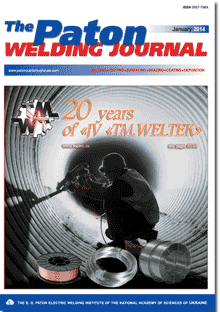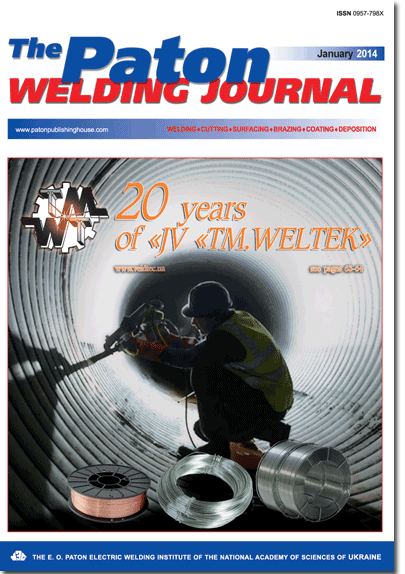| 2014 №01 (01) |
DOI of Article 10.15407/tpwj2014.01.02 |
2014 №01 (03) |

The Paton Welding Journal, 2014, #1, 13-19 pages
STRUCTURAL CHANGES IN OVERHEATING ZONE OF HAZ METAL OF RAILWAY WHEELS IN ARC SURFACING
A.A. GAJVORONSKY, V.V. ZHUKOV, V.G. VASILIEV, T.A. ZUBER and A.S. SHISHKEVICH
E.O. Paton Electric Welding Institute, NASU. 11 Bozhenko Str., 03680, Kiev, Ukraine. E-mail: office@paton.kiev.ua
Abstract
The objective of the work is investigation of the parameters of welding thermal cycle (WTC) in arc surfacing, including heating and cooling stages, on formation of metal structure and properties in overheating zone of the HAZ of high-strength wheel steel of grade 2, containing 0.58 % C. Gleeble 3800 complex was used to conduct heat treatment of model samples at heating rate of 25 to 210 °C/s up to the temperature of 1250 °C with subsequent cooling by WTC (w6/5 = 2.5-64 °C/s), perform metallographic investigations of the structure and plot diagrams of overcooled austenite transformation. At testing by the Implant method influence of cooling rate and structural state of metal in overheating zone of HAZ on critical stress values at delayed cracking of wheel steel was assessed. It is established that incompleteness of the processes of metal austenite homogenizing in arc surfacing, because of its fast heating and limited time of soaking at the temperature above Ac3, has an essential influence on subsequent g-a transformation in the HAZ metal. This leads to lowering of the critical cooling rate to 20 °C/s, at which not more than 50 % of martensite forms in the structure (w50M). It is shown that the high delayed fracture resistance of HAZ metal on the level of scr У 0.45s0.2 can be ensured, provided w6/5 Г w50M. Investigation results can be used at specifying the technology of building-up by surfacing of items from high-strength steels. 12 Ref., 4 Tables, 4 Figures.
Keywords: arc surfacing, wheel steel, thermal cycle, HAZ, austenite transformation diagram, structure, martensite, bainite, delayed fracture
Received: 20.08.13
Published: 28.01.14
References
1. Shorshorov, M.Kh. (1965) Metals science of welding of steel and titanium alloys. Moscow: Nauka.
2. Gulyaev, A.P. (1978) Metals science. Moscow: Metallurgiya.
3. Grabin, V.F., Denisenko, A.V. (1978) Metals science of welding of low- and medium-alloyed steels. Kiev: Naukova Dumka.
4. Makarov, E.L. (1981) Cold cracks in welding of alloyed steels. Moscow: Mashinostroenie.
5. Gajvoronsky, A.A. (2013) Influence of diffusible hydrogen on delayed cracking resistance of high-carbon steel welded joints. The Paton Welding J., 5, 14-20.
6. Sarzhevsky, V.A., Gajvoronsky, A.A., Gordonny, V.G. et al. (1996) Influence of technological factors on structure and properties of HAZ metal in repair-reconditioning hardfacing of flanges of all-rolled train wheels. Avtomatich. Svarka, 3, 22-27, 33.
7. Gajvoronsky, A.A., Poznyakov, V.D., Sarzhevsky, V.A. et al. (2010) Influence of thermodeformational cycle of hardfacing on the structure and properties of high-strength railway wheels in its reconditioning. The Paton Welding J., 5, 15-18.
8. Astafiev, A.S., Gulyaev, A.P. (1972) About grain growth in near-weld zone. Svarochn. Proizvodstvo, 7, 45-47.
9. Livshits, L.S. (1979) Metals science for welders. Moscow: Mashinostroenie.
10. Grigorenko, G.M., Kostin, V.A., Orlovsky, V.Yu. (2008) Current capabilities of simulation of austenite transformations in low-alloyed steel welds. The Paton Welding J., 3, 22-24.
11. Cherepin, V.T. (1968) Experimental technique in physical metals science. Kiev: Tekhnika.
12. Gajvoronsky, A.A., Poznyakov, V.D., Markashova, L.I. et al. (2012) Influence of deposited metal composition on structure and mechanical properties of reconditioned railway wheels. The Paton Welding J., 8, 16-22.
Suggested Citation
A.A. GAJVORONSKY, V.V. ZHUKOV, V.G. VASILIEV, T.A. ZUBER and A.S. SHISHKEVICH (2014) STRUCTURAL CHANGES IN OVERHEATING ZONE OF HAZ METAL OF RAILWAY WHEELS IN ARC SURFACING. The Paton Welding J., 01, 13-19.The cost of subscription/purchase order journals or individual articles
| Journal/Currency | Annual Set | 1 issue printed |
1 issue |
one article |
| TPWJ/USD | 384 $ | 32 $ | 26 $ | 13 $ |
| TPWJ/EUR | 348 € | 29 € | 24 € | 12 € |
| TPWJ/UAH | 7200 UAH | 600 UAH | 600 UAH | 280 UAH |
| AS/UAH | 1800 UAH | 300 UAH | 300 UAH | 150 UAH |
| AS/USD | 192 $ | 32 $ | 26 $ | 13 $ |
| AS/EUR | 180 € | 30 € | 25 € | 12 € |
| SEM/UAH | 1200 UAH | 300 UAH | 300 UAH | 150 UAH |
| SEM/USD | 128 $ | 32 $ | 26 $ | 13 $ |
| SEM/EUR | 120 € | 30 € | 25 € | 12 € |
| TDNK/UAH | 1200 UAH | 300 UAH | 300 UAH | 150 UAH |
| TDNK/USD | 128 $ | 32 $ | 26 $ | 13 $ |
| TDNK/EUR | 120 € | 30 € | 25 € | 15 € |
AS = «Automatic Welding» - 6 issues per year;
TPWJ = «PATON WELDING JOURNAL» - 12 issues per year;
SEM = «Electrometallurgy Today» - 4 issues per year;
TDNK = «Technical Diagnostics and Non-Destructive Testing» - 4 issues per year.


